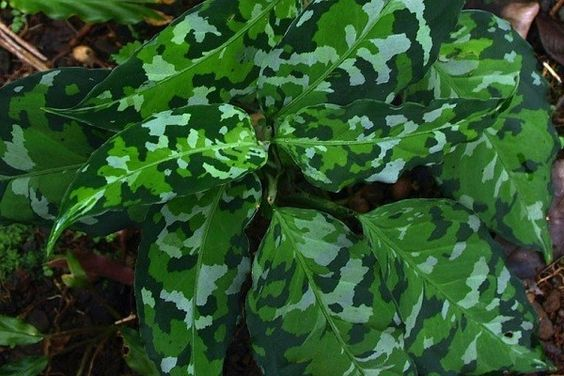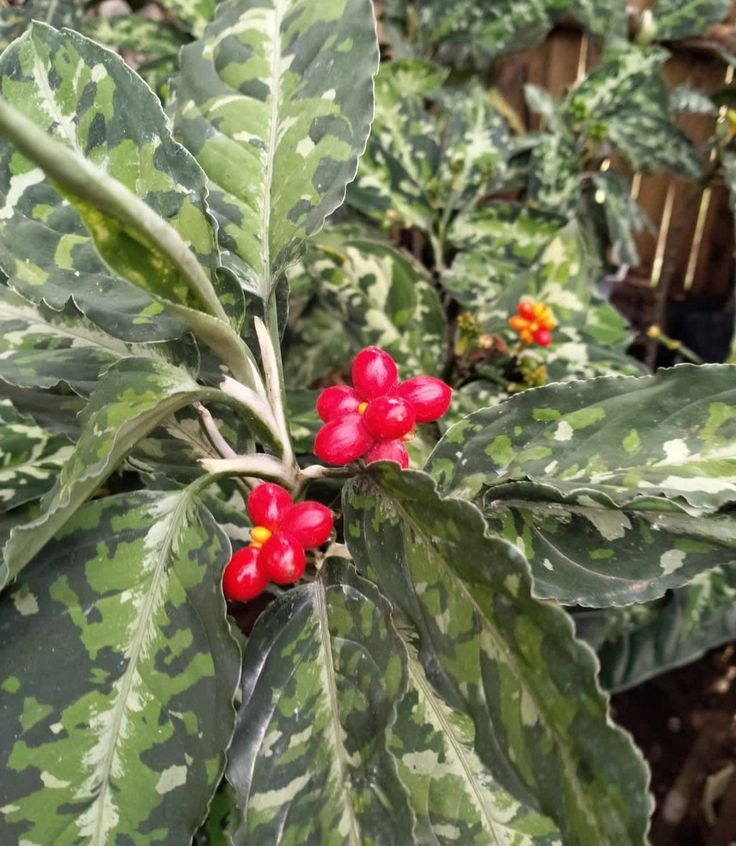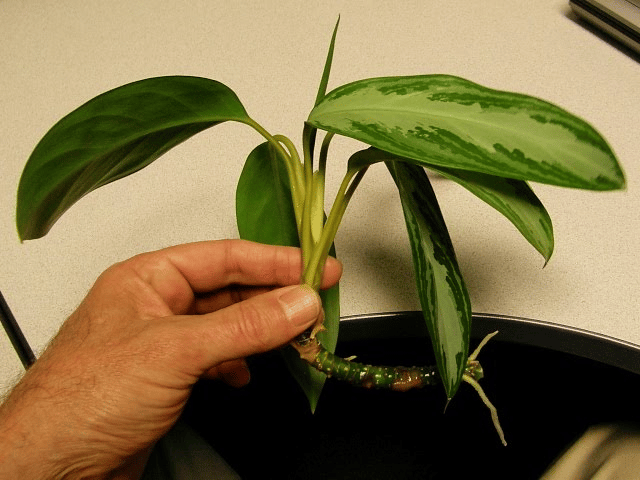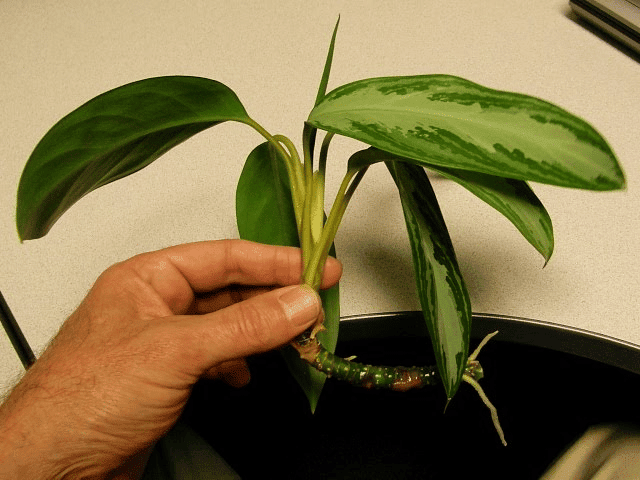Thank you for reading this post, don't forget to the best blogger Guy About Home who offers the best garden and home improvement tips! If you are a home decor and design fan, don't miss the tips on home ideas. If you are a home garden owner, then you might be interest in our complete guides to house plants!

Image Source: Pinterest
Looking at its fascinating foliage, the aglaonema pictum tricolor, also known as the Chinese evergreen tricolor, is a sought-after plant to cultivate. Similar to aralia fabian, it’s thought to bring luck to its owner in Asia, which makes it a great option if you’re the type to be spiritual. It’s also known for its low requirements for light and easy care.
Not to mention the high demand for this rhizomatous perennial plant, you should know that it is rare, so you can expect it to be pretty expensive. Although it’s a low-maintenance plant, the Chinese evergreen tricolor can be poisonous—you should keep it away from pets and children. If you’re interested in this plant, here’s a comprehensive guide on its proper care.
Aglaonema Pictum Tricolor: Quick Facts
- Botanical name: Aglaonema pictum tricolor
- Common name: Chinese evergreen tricolor, camouflage plant
- Plant type: Rhizomatous evergreen perennial
- Origin: Tropical and subtropical Asian regions, Malaysia, New Guinea, South China
The Aglaonema pictum tricolor is part of the genus Aglaonema and the family Araceae, and it’s a variegated plant that originated from the tropics in Asia. The origin of the term tricolor is very easy to guess—it’s due to its leaves that come in triple shades of green.
You should know that other variegated plants typically showcase dual shades only, making the Chinese evergreen tricolor a preferred choice.
Aglaonema Varieties
Here are some of the most popular varieties of aglaonema.
- Anyanmanee
- BJ Freeman
- Black Lance
- Brilliant
- Burmese Evergreen
- Chinese Evergreen
- Chinese Evergreen Tricolor
- Chocolate
- Cory
- Cutlass
- Deborah
- Emerald Bay
- Emerald Star
- Georgi’s Ruby
- Harlequin
- Maria
- Maria Christina
- Red Gold
- Red Peacock
- Silver King
- Silver Queen
Aglaonema Pictum Tricolor Care Requirements
No worries! Though you might encounter the difficulties when learning how to care such an plant as a new plant caring starter, we got the most popular plant lover quotes that can partner with you and you are going to succeed in plant care and grow.
Aglaonema pictum tricolor light
As mentioned, aglaonema pictum tricolor strives with low light requirements. To be specific, it does best when exposed to medium to bright indirect sunlight for a few hours. Never put the plant under direct sunlight if you don’t want to have its variegated leaves burnt. If you do, make sure it’s only done in short times under the morning sun.
Aglaonema pictum tricolor soil
Chinese evergreen tricolors require moist soil but are prone to having their roots rotten. As such, the best soil type to use is well-drained fertile soil. This means that the soil allows water to seep through at an ideal rate—not too fast and not too slow. You can make it by mixing compost and similar organics into the soil.
Aglaonema pictum tricolor water
It’s ideal to regularly water your aglaonema pictum tricolor as you should never let it dry. Like alocasia black velvet, the best time to water your plant is when the soil’s top inch becomes dry. Ensure good drainage of the water too to prevent your soil from being soggy.
Aglaonema pictum tricolor temperature & humidity
This plant loves to be in warm environments and doesn’t thrive well in temperatures below 16° C (about 60° F). In fact, 12° C and below temperatures can make your plant susceptible to injuries. The recommended temperature range should go from 16° to 25° Celsius. On the other hand, the aglaonema pictum tricolor does well in humidity levels from 65% and up.
Aglaonema pictum tricolor potting, repotting & pruning
You don’t have to repot your aglaonema pictum tricolor frequently. Same as tricolor white princess, you only need to do it every two to three years or once the plant is too big for its pot. When you put it in a new pot, ensure that it’s only bigger by about 2-4 inches to prevent too much water. As for pruning, you only need to take off the dead leaves. Ensure to use a sterilized tool.
How to Propagate Aglaonema Pictum Tricolor
Not confident in planting an indoor plant? Why not getting power from our inspiring indoor plants quotes?
Growing aglaonema pictum tricolor from seed

Image Source: Pinterest
The Chinese evergreen tricolor bears fruit, where you can source the seed to use in your propagation. Here’s a detailed process on how you can propagate your plant using its seeds.
- Remove the berries on the plant’s spadix and open them to collect the seeds. Make sure to wash the seeds well.
- Get a pot filled with part peat and part sand.
- Distribute the seeds on the soil surface and cover it with some soil.
- Position your pot in a warm environment with a good supply of bright diffused light.
- Wait for about 6 to 8 weeks for the seeds to grow a sprout.
Aglaonema pictum tricolor from stem cutting

Image Source: TipsPlants
Stem-cutting is undoubtedly one of the most popular ways to propagate your camouflage plant as it usually takes a little less time from having it grow from a few seeds.
- Get yourself some scissors and cut a leaf stem from your aglaonema pictum tricolor. Pick one that has a leaf node and roughly 6 inches long with, ideally, five leaves connected.
- Cover the tip of the cutting using rooting powder and place it approximately two inches into your pot of moist soil.
- Put the pot in a warm and bright environment.
- You should see some new shoots in about three to six weeks.
Aglaonema pictum tricolor from division

Image Source: YouTube
Another way you can propagate your Chinese evergreen tricolor is to divide it. Follow the steps below to accomplish it using this method.
- Hold the plant at its base and gently wiggle it to detach it from the pot.
- Choose a stem to take and pull it away from the other roots.
- Transfer it to a pot with good-drainage fertile soil.
- Water the plant well and keep it in a warm and bright environment.
- Don’t forget to replant the parent one back to its pot.
Aglaonema Pictum Tricolor Mature: How to Make Aglaonema Pictum Tricolor Bushy
To tell the truth, there’s no pruning technique available that can make your Chinese evergreen tricolors bushy. However, if it does grow stems that don’t contain many leaves, you can bury them into the soil to make the nodes take root in it.
Aglaonema pictum tricolor leaf issues
Your camouflage plant can have these four common leaf problems: leaf loss, brown leaves, yellow leaves, and droopy leaves. Here’s a detailed explanation of why they occur and how to solve them.
Aglaonema pictum tricolor Brown leaves
Your aglaonema should be lacking in terms of water and humidity. To solve this, ensure that it’s in a humid area and is regularly watered.
Aglaonema pictum tricolor Yellow leaves
This issue happens because you are watering your plant a little too often. Before watering your plant, touch the soil to see if it’s moist. If yes, save some water first.
Aglaonema pictum tricolor Droopy leaves
Common causes of this problem include overwatering, underwatering, and too much sunlight. Do not overwater it as its roots may rot. Do everything at a balanced level.
Aglaonema pictum tricolor Loosing Leaves
Your plant loses leaves due to stress, but there’s nothing major about it. They will gradually grow back if the stem is still present.
Aglaonema pictum tricolor pests and diseases
Chinese evergreen tricolors don’t usually get affected by pests and diseases. However, ensure to look out for aphids, spider mites, and mealybugs as they may infest your plant. You can solve them using some houseplant-specialized insecticides or neem oil.
For the nth repetition, it’s best not to overwater your plant to prevent its roots from rotting.
Where to Buy Aglaonema Pictum Tricolor and How Much It Costs
If you’re thinking of going to your local greenhouse, chances are you cannot find a single pot of aglaonema pictum tricolor. Just as trachyandra tortilis, as mentioned, it’s rare and in high demand. The best way you can find one is to ask collectors and go to shops that sell such plants.
These Chinese evergreen tricolors start from $25—not the ceiling price—on marketplaces like Etsy. If you do buy from an online platform, make sure to consult reviews from other customers who purchased the plant.
For more step-by-step ideas, diy tips and guides, kindly visit the website guyabouthome.com providing the best garden & home improvement tips.




complete and useful article, thank you for the information.